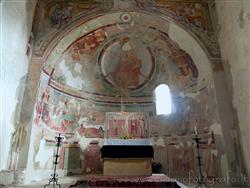|
Oleggio (Novara, Italy): Church of San Michele
|
|
|
Show an other place around Milan worth a visit: |
 The church, dedicated to San Michele (St. Michael), is located inside the Oleggio cemetery and represents an important example of Romanesque architecture in the Novara area, both from an architectural point of view and from the point of view of the pictorial decorations it contains. The church, dedicated to San Michele (St. Michael), is located inside the Oleggio cemetery and represents an important example of Romanesque architecture in the Novara area, both from an architectural point of view and from the point of view of the pictorial decorations it contains.
The oldest document in which the church is mentioned is of the year 973. The currently visible building, in Romanesque style, however, was probably built in the mid-eleventh century to replace the previous of the Longbard period.
During the sixteenth century, the church was abandoned in favor of the new parish church of St. Peter, located in the fortified area of the town. The church suffered after that a long period of decline and only thanks some maintenance works aiming to preserve the cemetery church function it wasn't lost completely.
The architectural structure of the church, that of a basilica, has preserved its archaic Romanesque style. The walls, made of a succession of river stones and brick pieces, give the building an unique color effect.
The salient façade, crossed vertically by pilasters that are connected to each other by hanging bows, suggests the internal division into three naves. The front door is placed in an eccentric position with respect to the longitudinal axis of the facade. At the same time, the facade itself is not placed at right angles to the long axis of the church. Both things probably reflect the adaptation of the building to the walls of the previous church. Not original is the window on the facade in corrispondence to the right lateral nave, window that was added when in 1710 the ossuary was built, ossuary then demolished at the beginning of the twentieth century.
In the upper part of the facade there is furthermore a small opening in the shape of a cross.
The side walls are also decorated with pilasters and suspended arches in brick; in it single lancet windows strongly splayed to the outside. The rear part of the church is characterized by the presence of three semicircular apses (typical element of the Romanesque), which also are enriched by the presence of pilasters and suspended arches. Various windows of the apses are walled. In particular, of those of the central apse only one has remained open.
The interior is divided into three naves - with the central one both higher and larger than the lateral ones - separated by rectangular pillars, baseless and without capital, connected by arches. The three naves coverage is trussed.
The presbytery - as often happens in Romanesque basilicas - is in a raised position relative to the floor of the church. Below the presbytery there is a crypt which can be accessed from the two lateral naves. Rather rough columns (some square, others octagonal) lacking both basis and capital separate the three aisles in which the crypt is divided. The columns support a low vaults marked by pronounced ribs.
The church keeps inside the remains of important cycles of Romanesque frescoes dating from the second half of the eleventh century, although large part of the original frescoes, which originally were likely to occupy the entire internal vertical surfaces, have been lost.
- In the counter facade there is a great representation of the Last Judgement (Figure 2), with a central figure (now almost completely unreadable) of Christ the Judge. It occupies completely the whole part above the entrance door.
- On the right wall, next to the counter facade, a scene that takes place in an urban environment and that can be interpreted as the finding (or translation) of a saint's body (Figure 2 left in photo)
- On the right wall at the top it is possible to recognize a reprentation of Our Lady of Sorrows
- Noteworth on the first right arch against the counter facade a fresco of a peacock, an ancient symbol of immortality
- Central apse: At the top center a Christ Pantocrator, on the left the image of St. Michael the Archangel leading a host of angels, on the right what remains of a Madonna richly decorated according to the canons of the Byzantine art. On the cylinder probably a depiction through images of the Liber de apparitione Sancti Michaelis in Monte Gargano.
- Right aps: another Christ Pantocrator in an almond supported by figures of angels and in the lower register figures of deacons
Furthermore there are also frescos of later epochs. Among them:
- Above the archaic main altar there is a Crucifixion with the Virgin, Mary Magdalene, John the Evangelist and St. Michael the Archangel, a rather simple work dated 1587
- A resurrection of Christ dating between the late fifteenth and the early sixteenth century, work of the of the Novara workshop of Cagnola
- A Saint Michael Archangel is depictedThe on the first right pillar, painted by the painter of Polish origin, but of Oleggio by adoption, Johannes Maria de Rumo active in the mid-sixteenth century
- A curious memento mori, possibly of the sixteenth century, on the right wall near the window on the facade (photo 4)
Categories: Places of historical value of artistic value
Via Mezzomerico - 28047 Oleggio (No) |
Further pictures of Church of San Michele in the section Photography |